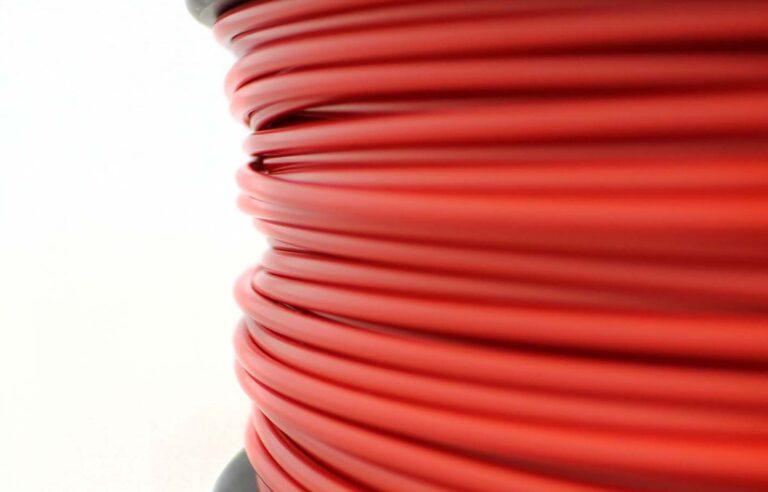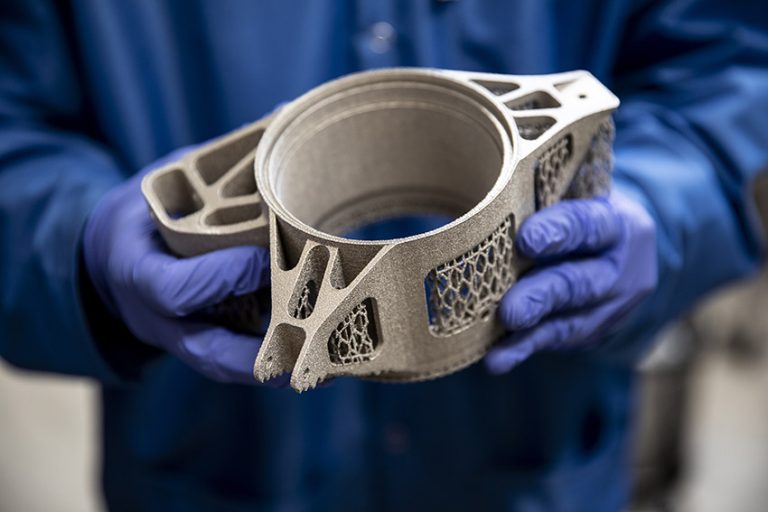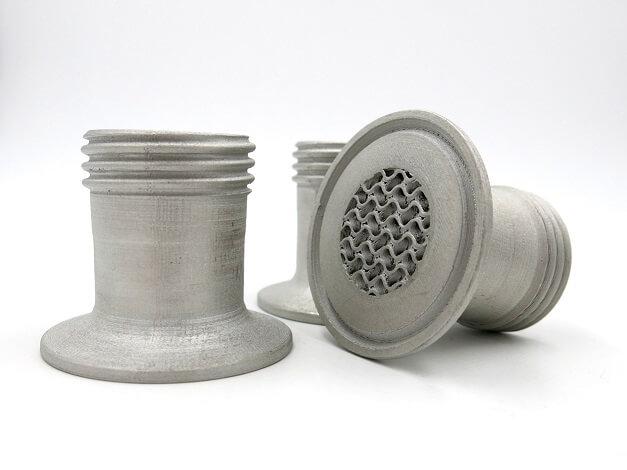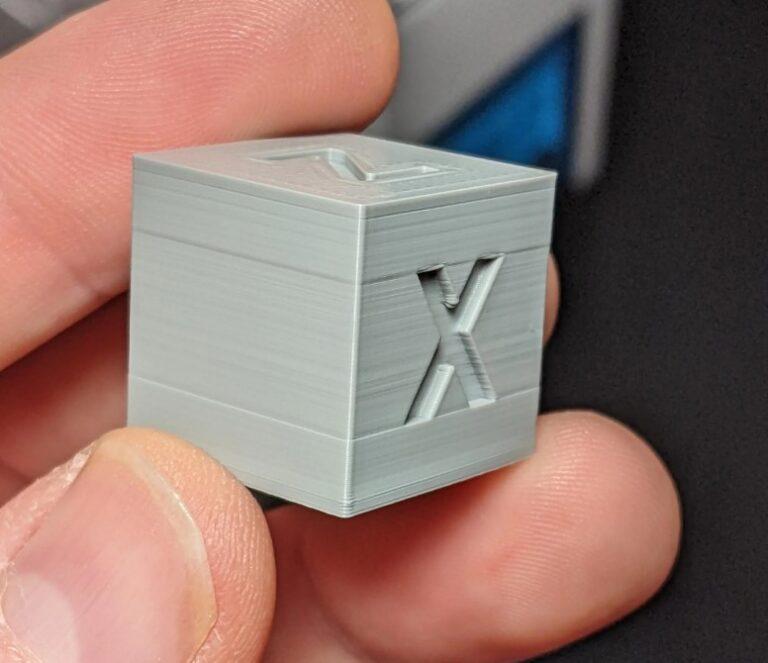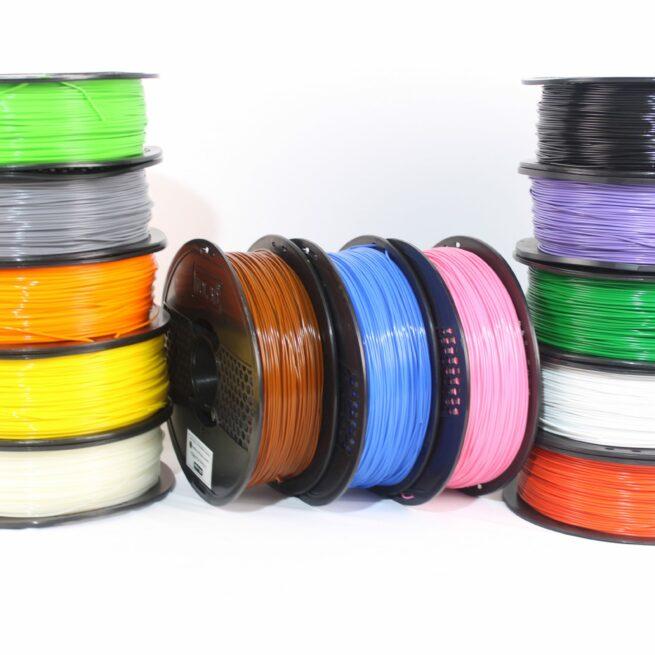Metal Additive Manufacturing, A Beginner’s Guide
Metal additive manufacturing is an exciting new way to produce metal parts. It differs from traditional metal manufacturing processes in several ways. As an engineer, additive manufacturing is something that you should get excited about. It could change the future of metal 3D Printing and what’s produced.
Using metal additive manufacturing you can fabricate a wide range of metal parts. It is also known as metal 3D printing. This allows you to be more creative than ever before. The picture below is a prototype of an Airbus A380 bracket better than the one in the background. (Photo courtesy of EADS)
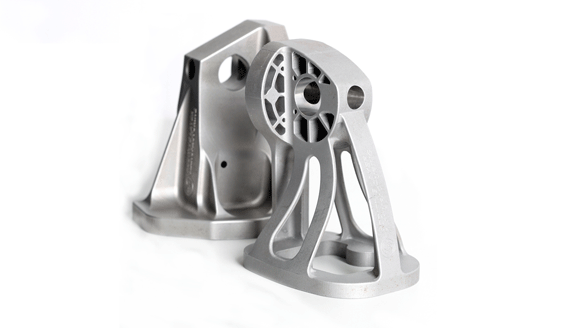
We can now produce components that would have been impossible to manufacture with various metal powders a few years ago. Additive Manufacturing is no longer a prototyping technique; currently, we use it to create a series of components for the most demanding applications.
Additive Manufacturing, often known as 3DPrintingg, creates three-dimensional items layer by layer from a polymer or metal-based substance. The process works by sending a digital data file to a computer, producing the component.
History of Metal Additive Manufacturing
Additive manufacturing can be traced back to the mid-1980s when a new method for speedier product development came about. The original name for this method was “rapid prototyping”. The 3-D printer could make models to check the fit and function of the prototype. We can check the model’s fit and function before it was changed.
In 1987 the company earned its first patent for Stereolithography (SLA). This is a technique for making three-dimensional objects from plastic. The laser can harden a UV-sensitive liquid polymer in a matter of seconds. Manufacturers may use this process to build 3-D models more rapidly than ever before. The introduction of 3D printing created revolutionary opportunities for manufacturers, engineers, and designers.
early 1990s
By the early 1990s, various alternative polymer-based additive manufacturing methods had been available on a commercial scale. Metal additive manufacturing was discovered, patented, and made commercially available shortly after Selective Laser Sintering (SLS). Manufacturers have used metal additive manufacturing since 1992.
Like other additive manufacturing processes, this method allows metal prototypes, products, and tools to be fabricated quickly. While metal additive manufacturing processes make it possible to create metal parts, they are not alloys. The result was materials that were more like composites than alloys. This result is because we can now combine low melting points with high-resistance metals, like stainless steel.
Metal 3D Printing Processes
The additive manufacturing process involves layering, manufacturing anything from metal, plastic, or ceramics. A new way of manufacturing products is to build them up in layers, a process known as additive manufacturing. A new way of manufacturing products is to build them up in layers, a process known as additive manufacturing. This method can be used in place of traditional ways of making things, such as cutting and milling.
Additive manufacturing begins with creating a design using CAD(Computer-Aided Design) software or scanning an object to produce the final product. The software converts the scan into a precise structure that the 3D printer can follow.
Metal 3D printing is a subset of additive manufacturing that produces metal parts. Additive manufacturing to create objects entirely of metal. Layering metal powders can be used to create precision objects in a variety of shapes. These techniques may require an energy source or chemical binding agent. Additive manufacturing machines have more advanced today. They can now make objects that we couldn’t manufacture a few years ago. They can do this by using new strengths and standards and different materials that we couldn’t have thought of before.
It continually extends the variety of metal powders accessible in additive manufacturing techniques. Stainless steel, nickel, cobalt-chrome, titanium alloys, and aluminum are only a few of the different metals we commonly encounter. The ever-expanding selection of building materials enables the producer to select the most appropriate material for the particular specifications and expectations of the object under consideration.
Metal powders – the raw materials
The range of materials available for metal additive manufacturing systems is constantly expanding. Stainless steels, aluminum, nickel, cobalt-chrome, and titanium alloys are among the most often used materials, with some machine makers offering their proprietary materials.
The table to the right lists the most frequently encountered materials for laser melting operations. The trade names for materials differ from manufacturer to manufacturer; consequently, the word used here corresponds to the specifications on the material datasheets. In some cases, the term also contains the European nomination.
Standardization of methods and materials is underway, which is crucial to more accurate comparisons between products and quicker integration into current process chains.
Because of the large variety of materials available, the user has a good chance of selecting the most appropriate material to meet the standards of the product.
Individual materials for customers are also available from research institutes, universities, and system makers.
It is not possible to use all materials in Additive Manufacturing. Still, it is possible to qualify an accessible metal powder for a specific purpose in many circumstances with the correct equipment.
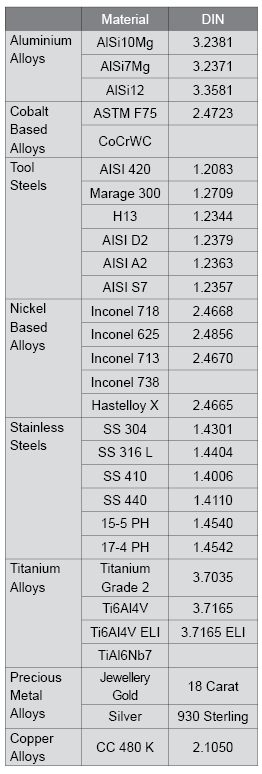

Metal Additive Manufacturing Techniques
Three additive manufacturing technologies use heat, binders, or lasers to join metal powder. These are the most common ways to make metal with additive manufacturing. Depending on the technology used, the resultant printed part may have a net shape or a near-net shape.
Laser-Based Powder Bed Additive
Powder bed fusion (PBF) technologies use either a laser or an electron beam to melt and fuse metal powder into a solid, a process known as powder bed fusion.
Among the metal additive manufacturing methods included in this method are:
- Selected laser melting (SLM)
- electron beam melting (EBM)
- direct metal laser sintering (DMLS)
- selective heat sintering (SHS)
- selective laser melting (SLM)
SLS (Selective laser sintering) is a different approach that uses a laser as the power source to sinter powdered materials; Unlike other processes, SLS uses polymers rather than metals.
All powder-bed processes involve spreading metal powder over layers already formed. Rollers or blades can be used to spread the metal powder over previous layers. The most typically used metals are stainless steel, titanium, aluminum, steel, cobalt chrome, and copper in this additive process.
Selective Laser Melting (SLM)
Researchers often use the term “Selective Laser Melting” to refer to a variety of the processes used for 3D printing metal objects. DMLS, SLS, DMP, and LPM are all similar processes that use a laser to melt the metal powder.
Selective Laser Melting (SLM) machines account for most Powder Bed Fusion equipment. SLM machines employ high-powered lasers to join metal layers together to form finished products. The printer’s operator takes the part, removes it from the build plate, and post-processes the part. The Selective Laser Melting technology is the current industry standard for metal printing. The Metal Additive Manufacturing industry now sells SLM machines.
gold standard
Some researchers commonly refer to selective laser melting as the gold standard in metal 3D printing. Because of its many advantages over other technologies. SLM-printed parts are ideal for producing precise, geometrically complicated pieces that would be impossible to machine using traditional methods. We can find them in various applications, ranging from dental and health care to aerospace. Metal printers are available in a wide range of sizes, from small (100mm x 100mm x 100mm) to large (800mm x 500mm x 400mm). Print speeds are average. The width of the laser beam and the height of the layers dictate these machines’ precision. We may use most materials that are now accessible for 3DPrintingg on an SLM machine.
While these machines are revolutionary, they are only suitable for industrial users due to many facility and post-processing requirements. People who have received specialized training must operate SLM machines. We must print multiple pieces, as the printing process is very delicate. We must adjust several times to achieve our desired results. The majority of parts require extensive post-processing and heat treatment once We have printed them. Furthermore, the metal powder that these machines employ is both exceedingly dangerous and expensive to handle: most fully baked SLM machines cost upwards of 1 million dollars to implement and require the services of a specialized technician to run effectively and efficiently.
Electron Beam Melting (EBM)
Instead of using a laser to create parts, electron beam machines (EBM) use an electron beam. GE only manufactured EBM machines Additive, the only firm that does so. Although the electron beam produces a less precise part than SLM, the process is faster when making larger parts with the electron beam. The limitations, costs, and difficulties associated with these machines are nearly identical to those associated with SLM machines; yet, it employed them more frequently in aerospace and medical applications than anywhere else. EBM machines, like SLM machines, can cost upwards of $1 million to put up and require the services of a dedicated specialist to operate.
Metal Binder Jetting
This metal additive manufacturing technology is like a two-dimensional inkjet printer because it uses metal powders as building blocks. You can print metal components by jetting metal powders onto a build platform. Some printers use continuous feed, while others drop powder on demand. The layer joins the powder layer with a liquid binder, resulting in the production of the desired part.
We have just printed parts that are initially brittle and require post-processing steps such as sintering and infiltration to become more durable and strong. It is possible to have the finished product go through an optional finishing process in which the part is either polished and nickel-plated or gold-plated, as an example.
One of the most significant advantages of binder jetting is the avoidance of any melting of metal powders, which can result in the accumulation of residual tensions. This metal additive manufacturing technology is also one of the least expensive available options.
Sheet Lamination
This approach uses bonding, ultrasonic welding, or brazing to construct an object by joining sheets of material together layer by layer. Unlike other bonding procedures, sheet lamination is a low-temperature process that can attach diverse materials. We design standard sheet lamination processes to create visual and aesthetically pleasing models rather than structurally.
Directed Energy Deposition
It’s a complicated 3D printing technology that uses focused energy, like a laser or an electron beam, to melt the building material. It is being deposited layer by layer at the same time. Engineers widely use this technique to repair or add new material to existing structures. A heated nozzle deposits molten material onto a specific surface via Directed Energy Deposition (DED). The melted substance is typically titanium or cobalt chrome.
Powder DED
Also known as Laser Material Deposition (LMD), Blown Powder, and Laser Powder Deposition (LPD).
Direct Energy Deposition, the younger brother of Selective Laser Melting, is a method of fabricating metal parts that use a laser and metal powder. When constructing a part, DED machines accurately blow Powder out of a print head onto a part, utilizing an on-head laser to fuse the powder to the part throughout the production process.
BeAM DED 3D printer depositing and melting metal powder using a dual-purpose print head, as shown in the image below.
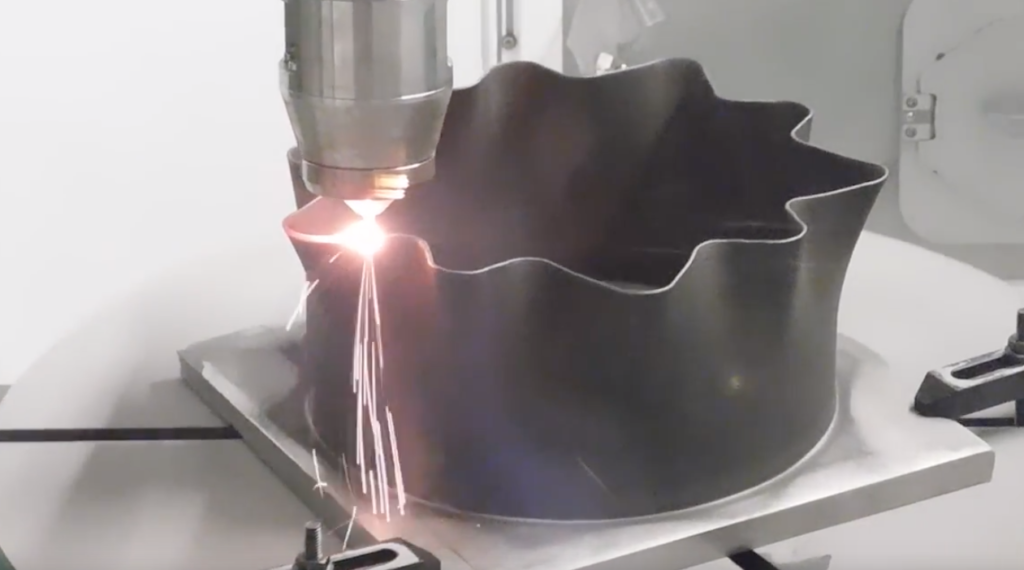

Given that both machines make use of metal powder and a laser, items printed with DED are pretty similar to those printed with SLM, with the notable exception that DED machines can “repair” non-printed parts that have flaws through the use of their proprietary powder distribution method. In terms of available materials, post-processing, and powder management requirements, they are comparable to SLM, and their machines are similar in the 1 million dollar range.
Wire DED
EBAM (Electron Beam Additive Manufacturing) is another term for this process.
Wire DED machines employ a laser to melt feedstock in a manner that is remarkably similar to its powder DED counterparts — the difference being that their feedstock is metal wire rather than blown powder. Larger construction volumes (as large as 5m x 1m x 1) and faster print times are possible with this technology, but the precision and quality suffer. It hence designed wire DED products to be substantially bigger and less accurate than parts produced by powder bed machines. These machines are costly, costing several million dollars per unit, and are extremely rare in the space industry.
Bound Powder Extrusion
Also known as Atomic Diffusion Additive Manufacturing, Bound Powder Deposition, Atomic Diffusion Additive Manufacturing
Bound Powder Extrusion (BPE) is a promising newcomer to the metal additive manufacturing sector, with the potential to revolutionize the industry. A significant difference between BPE machines and practically every other major 3D printing technique is the absence of loose metal powder. Instead, we use waxy polymers to bind the powder together, and we use metal feedstock to manufacture metal injection molding stock.
Consequently, bound powder extrusion material is considerably safer and easier to use than loose powder: hand can handle bound powder extrusion material and does not require the safety precautions required by flexible powder machines. A method like regular FFF 3D printing extruded BPE filament out of a nozzle to produce a “green” object containing metal particles distributed in a waxy polymer. There are two post-processing phases in BPE printing after we printed the part: first, it mostly dissolved the polymer in a “wash” machine; second, it sintered the washed component in an oven (similar to binder jetting). The part shrinks during the sintering process to accommodate the space created by the dissolved binder. The result is an entirely metallic component.
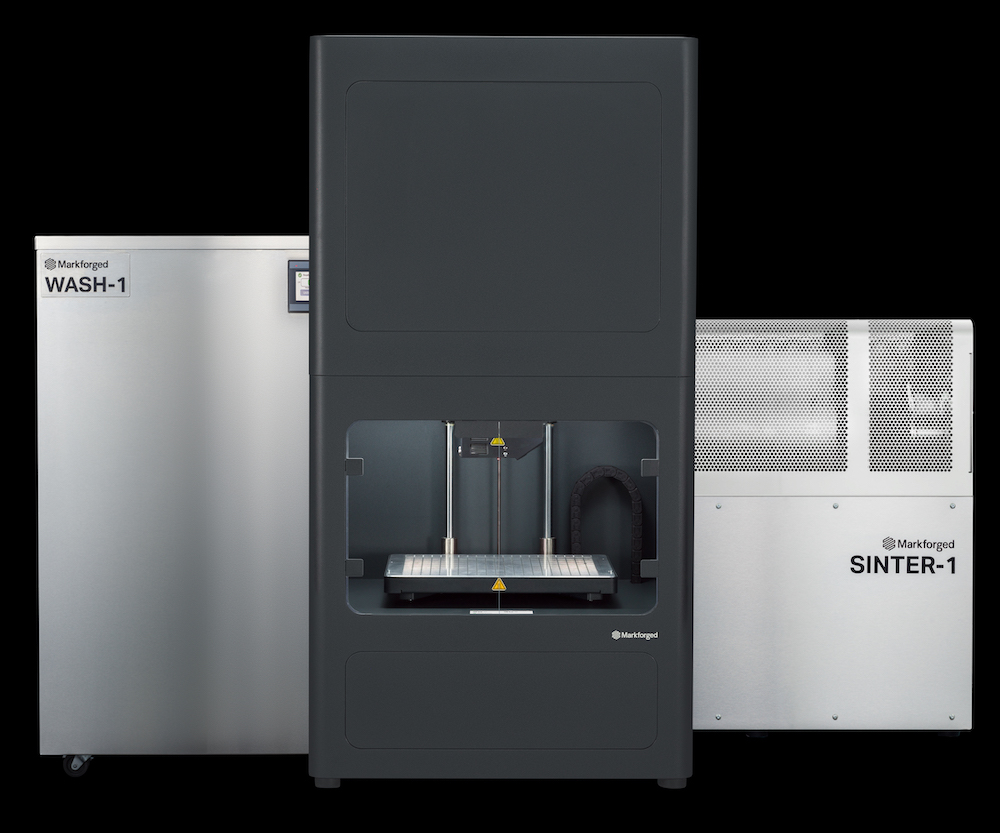

BPE metal additive manufacturing
Because BPE is a filament-based printing technique. The part restrictions of BPE parts are pretty similar to those of traditional FFF plastic printing: it works well for practically all part geometries. It can print with open-cell infill, for example. BPE parts still require post-processing, such as heat treatment for parts that need advanced properties (though this is necessary for every metal) and post-machining/polishing for improved surface finishes. Still, there is no powder management and fewer facilities requirements than traditional 3D printing. BPE machines take advantage of a more straightforward manufacturing process to be far more economical than all other major types of metal 3D printing, with machines ranging in price from $120,000 to $200,000.
Advantages of metal additive manufacturing Technology
Additive manufacturing technologies have significantly impacted manufacturing over the last few decades. They have made it easier and more efficient to make things. The ability to merge assemblies, printing a part as a single unit rather than many parts, reduces material waste and generally enhances product quality and performance. Aside from the waste-reduction benefit, metal AM processes provide many other advantages, including:
“Free” Complexity
When a part’s design gets more complicated, subtractive manufacturing processes like milling, contouring and finishing become more expensive. We need to do more subtractive milling, contouring, and finishing. When adopting additive manufacturing, the intricacy of a design adds little cost and, in many cases, lowers the part’s cost. If the part is prismatic – a solid rectangular block – milling from a near-net form billet is straightforward and takes few mills passes, resulting in a low cost.
Using Additive to print a block would necessitate multiple runs through the machine to deposit the required amount of material to build up the shape, resulting in a substantially higher cost. A brace that looks like a tree’s root structure will almost certainly need custom holding fixtures, multiple machine passes, numerous tool changes, and complex tool path coding if We’re going to mill it. This process will cost a lot of money. We designed the tool path automatically using software to print the organic shape using Additive. The number of passes and amount of material deposited is less, which means lower costs for this part.
Additional Costs Elimination
When compared to traditional methods, metal additive technologies reduce material waste. There is little need to subtract or shave off parts from the solid piece because the raw material is accurately produced layer by layer. Metal AM technologies are resource-efficient because only the material required is used and positioned where needed.
Metal additive manufacturing also decreases waste by obviating the need for costly tooling, saving your company money and time. You may access a wide choice of materials to satisfy your production demands by selecting the proper metal additive manufacturing technology.
wide range Various Materials
The chemical composition, crystalline state, and underlying micro-architecture of a material determine its qualities and overall performance. When selecting a material for a specific application, these features oblige engineers to accept inevitable trade-offs. However, thanks to improvements in 3D printing technology, this concession may soon be obsolete.
Previously, producers were limited to the materials that could be utilized in metal AM, but now there is a growing variety of metal powders that can be employed.
materials for metal additive manufacturing
- Stainless steel
- Steel
- Titanium
- Aluminum
- Copper
- Chrome Cobalt
- Alloys of titanium
- Nickel-based alloys
- Gold
- Silver
- Platinum
- Palladium
As additive manufacturing technology advances, the number of metal powders available for use will expand.
Design Improvements & Topology Optimization
Metal additive manufacturing allows for the creation of one-of-a-kind and sophisticated structures that would otherwise require the use of additional time and parts. By combining assemblies, we can make parts as a single unit for increased strength and efficiency, rather than a collection of parts that must be linked or fastened together after being manufactured before them.
Aside from that, recent advancements in automated design have made it possible to manufacture items for a diverse range of uses. Using Topology Optimization software, designers can provide the specifications of a part and then let the software develop its architecture based on the desired structural, functional, thermal, or other attributes of the component. We use this result to design parts that strength, lighter, tougher, and more resistant to natural forces and external environments because of the process.
Time Savings
Compared to traditional machining, one of the well-known advantages of metal additive manufacturing is reducing the amount of time it takes for products to migrate from the design stage to final production. Because there is less need for specialized machining and tools to process the object once it has been 3D printed, metal additive manufacturing can produce parts in days rather than weeks.
Benefits
- Multiple part consolidation – by designing as a single complicated component, the number of pieces in an assembly can be decreased.
- Reduce tooling costs – Parts can be made directly without tooling, lowering tooling costs.
- Access to complex geometries – Internal channels for conformal cooling, concealed features, thin walls, and fine meshes are just some of the intricate geometries that can be accessed.
- Freedom – There is no longer any restriction when new design principles are integrated with old subtractive and casting manufacturing methods.
- Lightweighting – entails only using material where it is necessary for weight reduction.
- Bespoke – Custom-made or personalized parts.
- Rapid design iterations – Rapid design iterations to production.
- Complementary tool – Additive manufacturing is a complementary technology integrated into existing production processes to reduce steps, time to market, and costs.
Is metal additive manufacturing affordable?
In addition, there are disadvantages to adopting metal additive manufacturing, the most significant of which is the high expense of acquiring and setting up metal 3D printing equipment. They have mostly relegated metal additive manufacturing to high-value industries such as aerospace, defense, and medicine due to the exorbitant cost of metal printers to date.
In addition to the initial equipment expenditure, additional costs include training, maintenance, and consumables. In addition, most things produced in this manner will require post-processing.
However, additive manufacturing costs are decreasing with time, and it is becoming increasingly accessible for smaller firms. So it is worth investigating whether this technology is appropriate for your company’s needs.
Metal additive manufacturing for SMEs
Small and medium-sized enterprises (SMEs) are frequently left behind when it comes to new technology. Many small and medium-sized enterprises (SMEs) cannot invest in technological advancements such as metal additive manufacturing due to budget constraints or risk aversion. In addition, the perceived difficulty of the activity frequently turns individuals off.
When it comes to prototyping during the product development stage, additive manufacturing can be precious – and Current parts can also be tweaked and improved with the AM. In addition, as previously said, adopting additive technologies rather than traditional ones expedites the manufacturing process, allowing your items to reach the market sooner.
reduce waste
Other advantages include the capacity to reduce waste – which is essential for people who work with expensive materials, such as jewelers – and the flexibility to customize products without re-tooling the manufacturing process.
Whether or not you use additive manufacturing will depend on whether or not it is the best technology available to meet your needs and how cost-effective it is. You may want to look into outsourcing additive manufacturing instead of investing in the technology.
What your competitors are doing and where any capital expenditure will provide the most significant competitive advantage are two additional essential questions to ask yourself.
A case study in metal additive manufacturing
An example of additive manufacturing in a small-scale setting
Three engineers and cycling enthusiasts from Melbourne identified an opportunity to take advantage of additive manufacturing technologies and materials to design a premium bike frame manufactured in their home country of Australia.
Their task was to design a super-light bicycle frame that was both sturdy and visually appealing enough to sell at a price that would be acceptable to the general public. As a result, they developed titanium components and carbon fiber tubing that used additive manufacturing techniques to create them.
With this achievement, Bastion Cycles has become the first company in the world to design, manufacture, test, and distribute a commercially viable, high-performance road bike made entirely of additive manufacturing.
In the beginning, the company concentrated on designing its components. It outsourced the additive manufacturing of those components until it decided to bring the additive manufacturing process in-house.
Metal prototypes were made to look into the technology and tested to ensure they passed the impact tests set by the ISO standard. It could redesign prototypes exceptionally quickly because of the advantage of modular design capability provided by additive manufacturing.
customize bicycle
Additive manufacturing opens up new prospects for the company that was previously unavailable through traditional bicycle manufacturing. It means that Bastion can manufacture frame walls as thin as 0.25 to 1.5mm and modify the geometry to provide complete personalization to their customers.
It is possible to create and configure a bike frame on the Bastion Cycles website, and clients can then track the progress of their bike frame throughout the manufacturing process. Bastion Cycles manufactures lightweight carbon-fiber bicycle frames. You can create and configure a bike frame on Bastion Cycles’ website, and you can follow your frame’s progress from start to finish.
Refrence
- cmtc.com
- metal-am.com
- markforged.com

